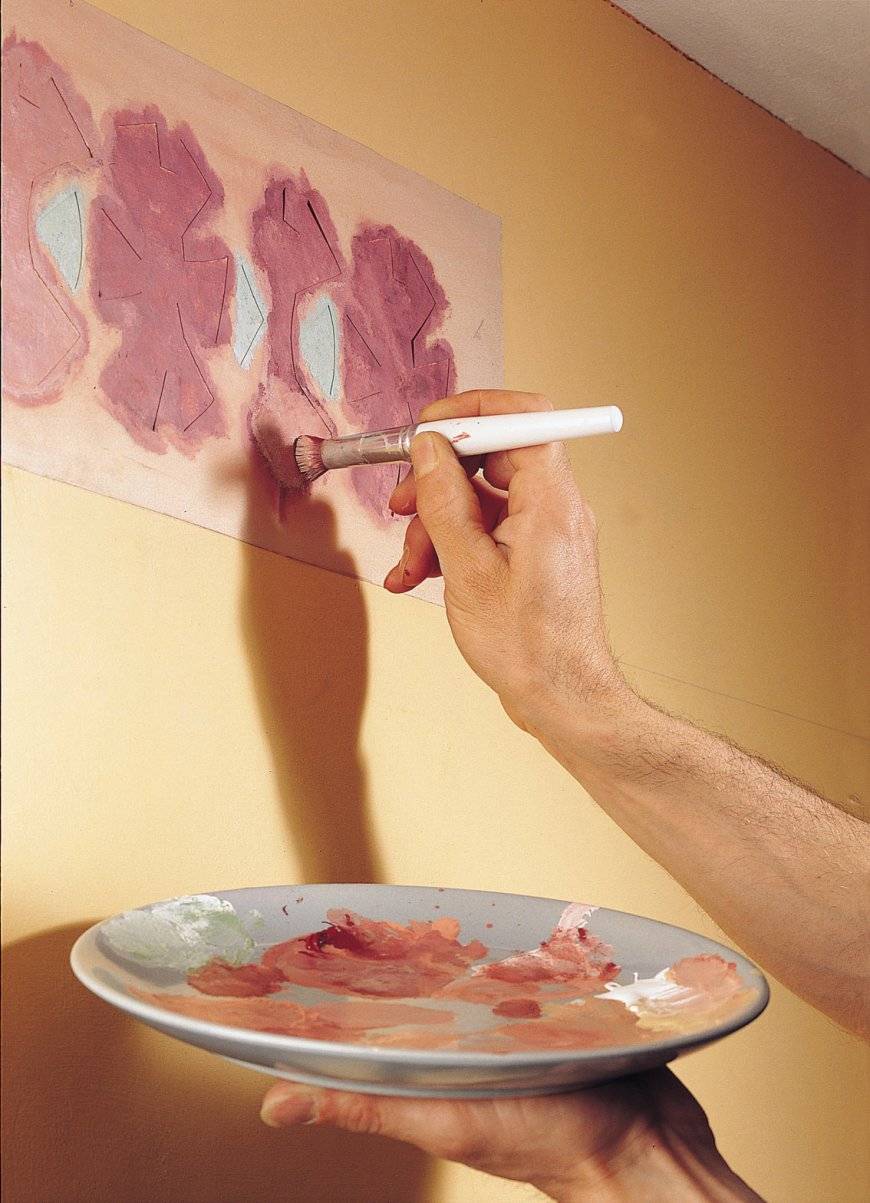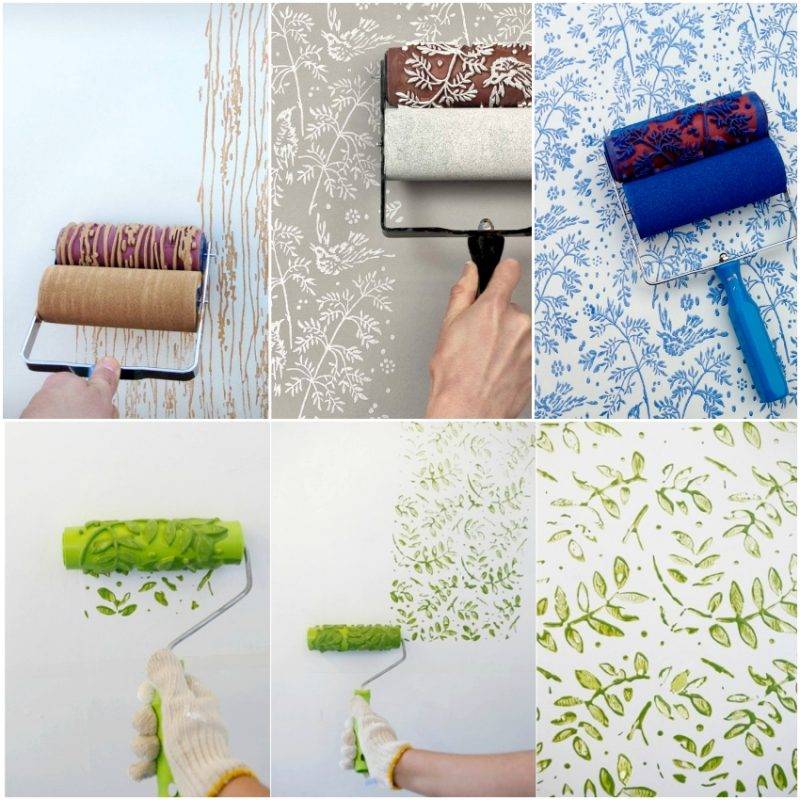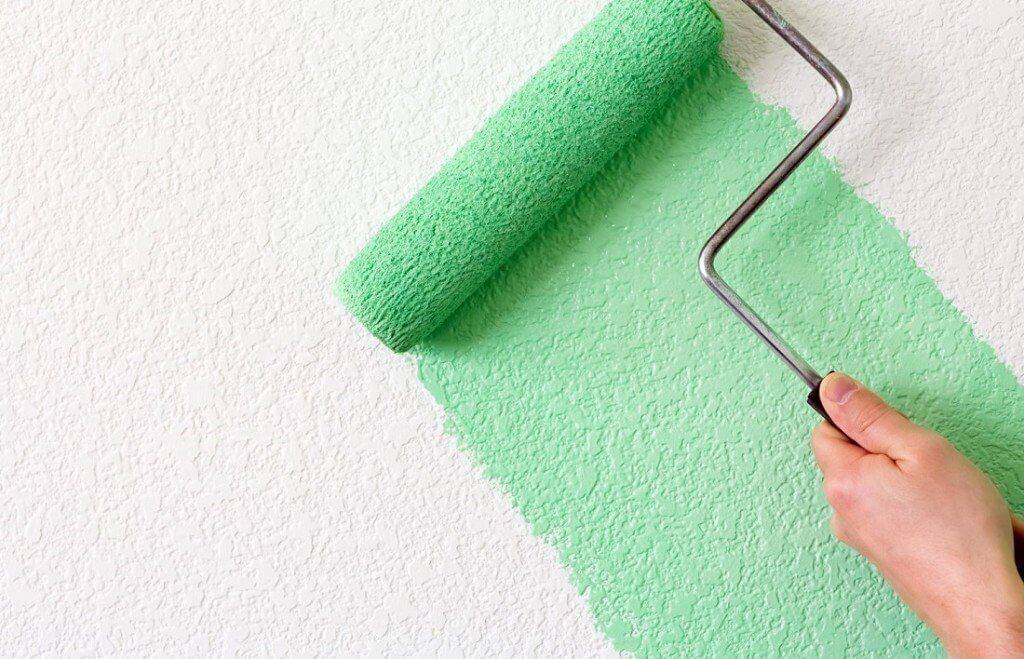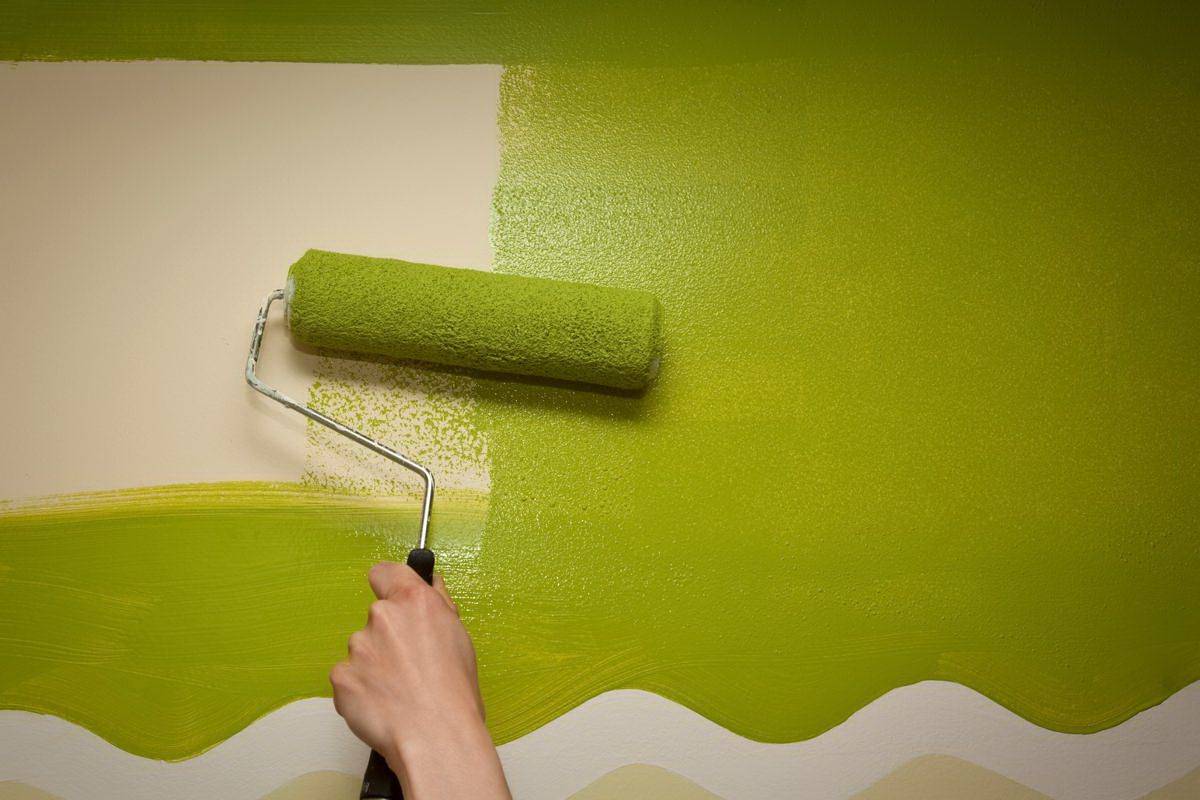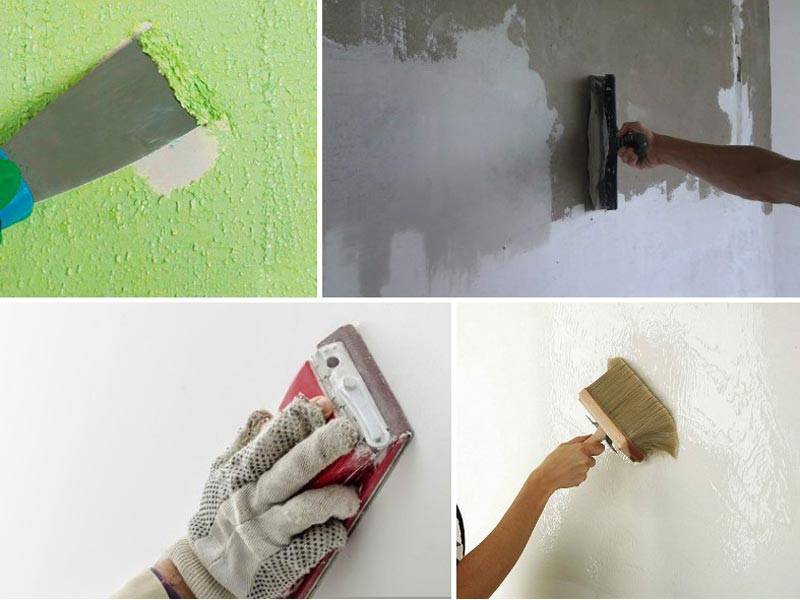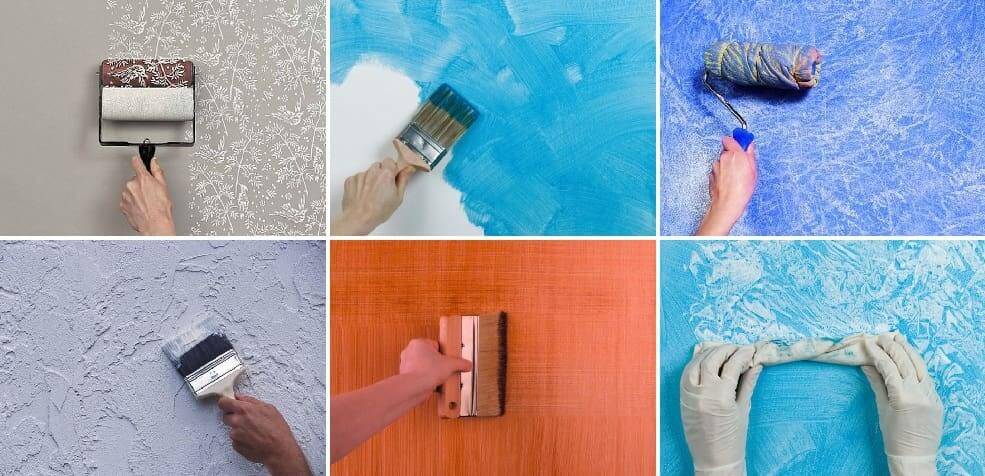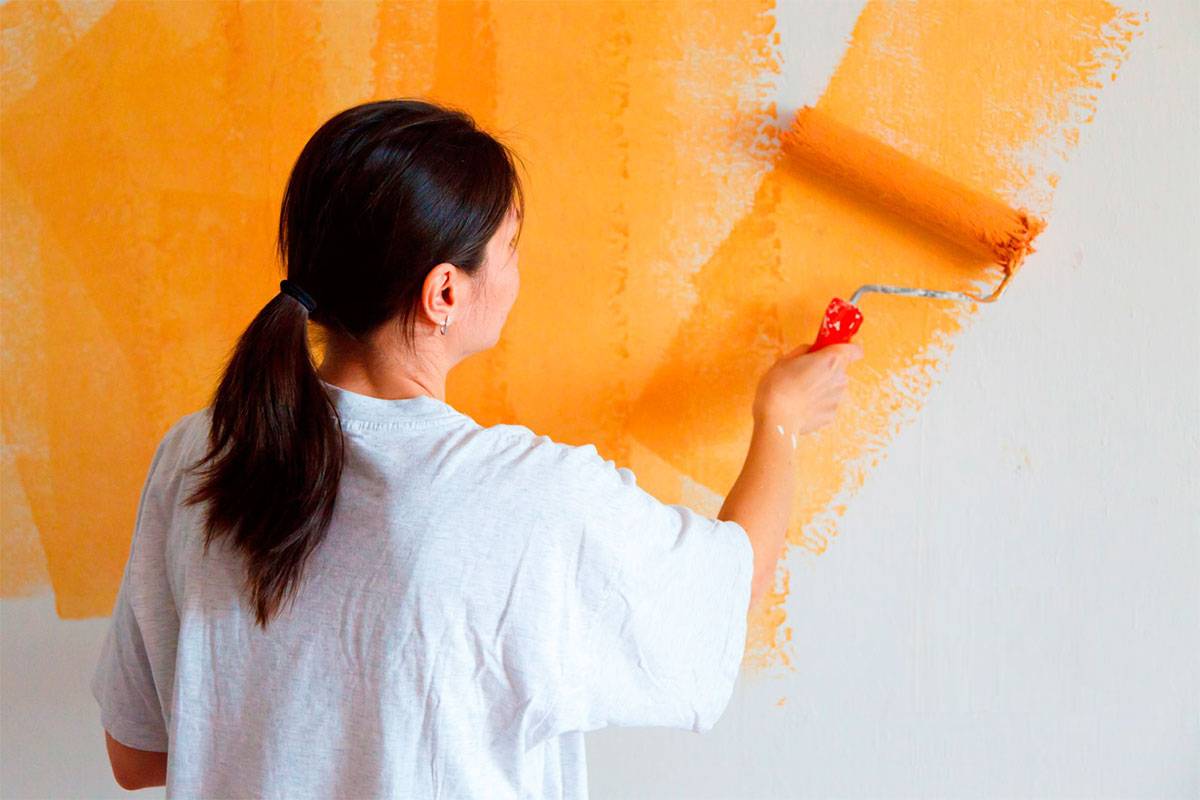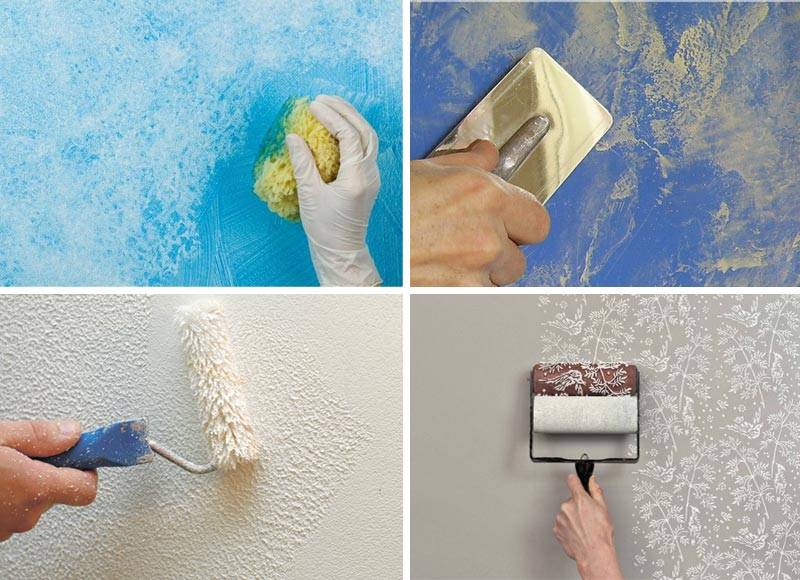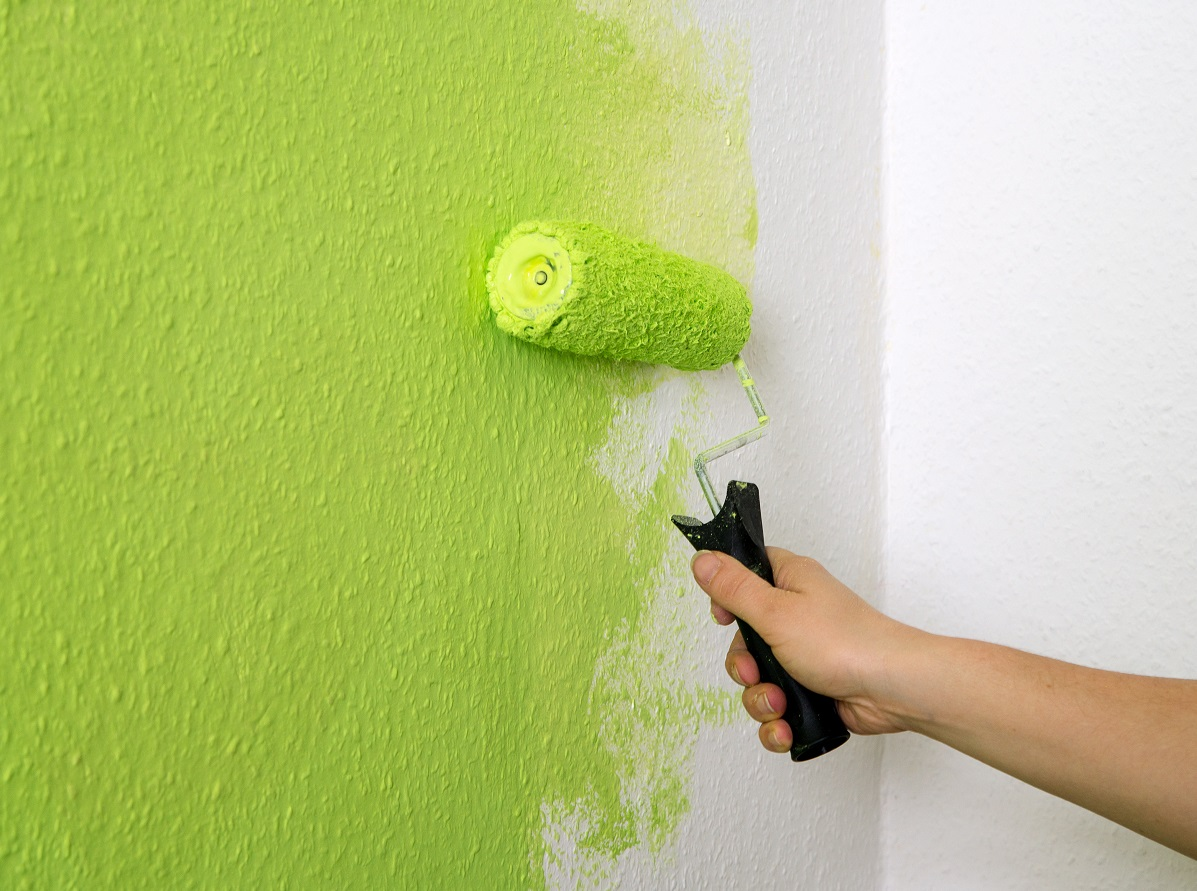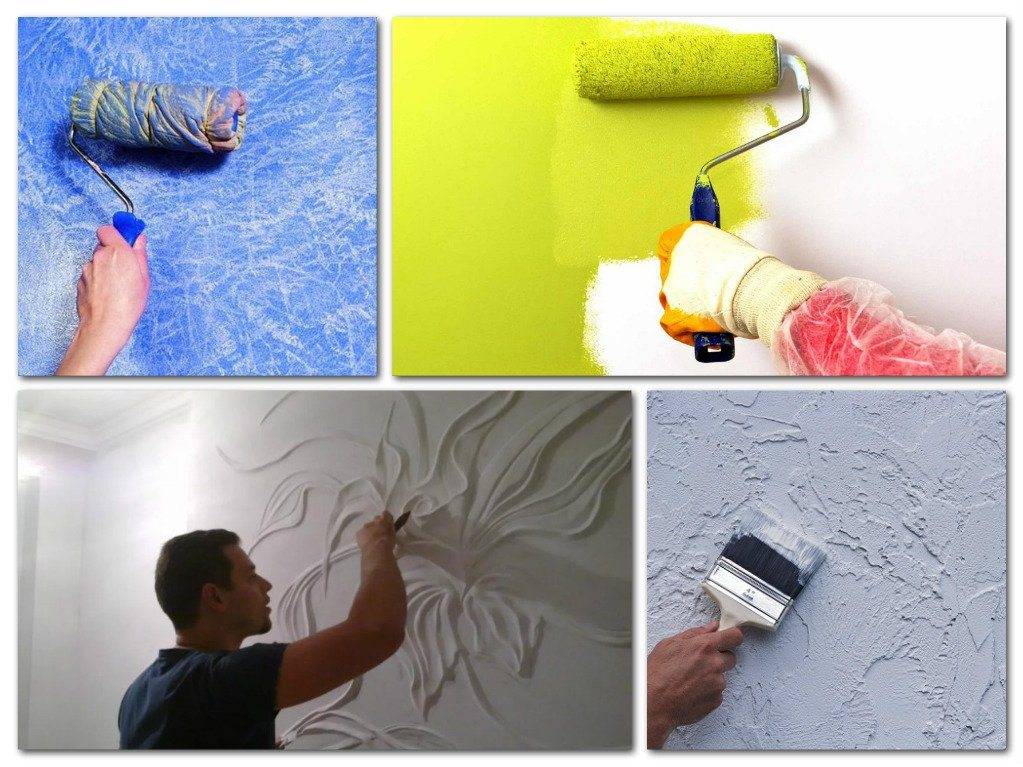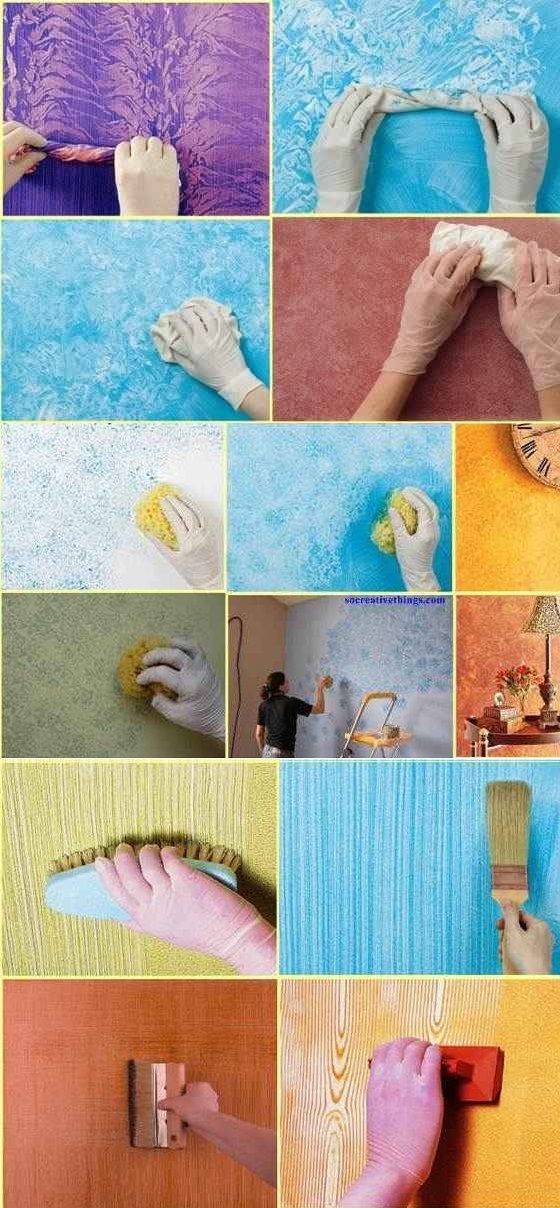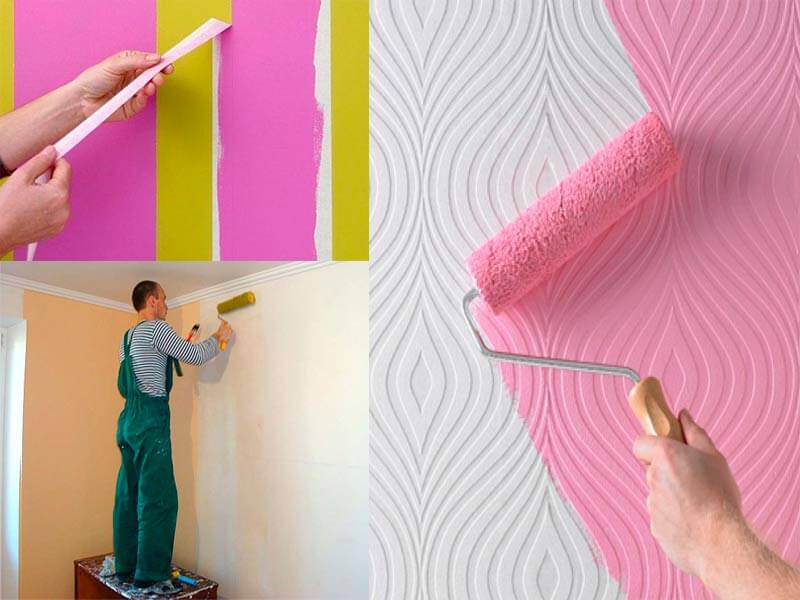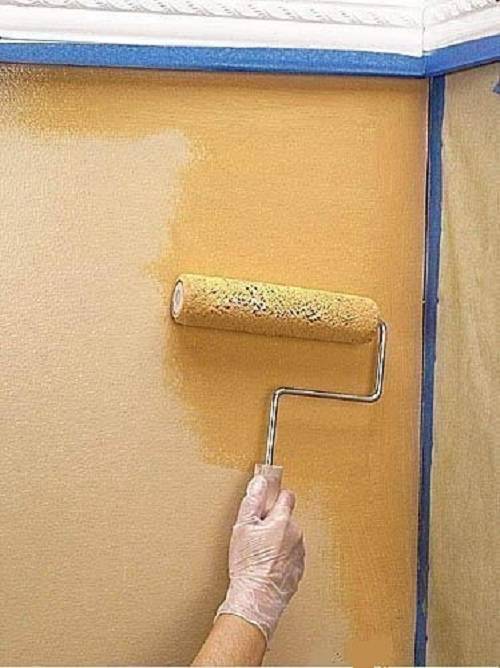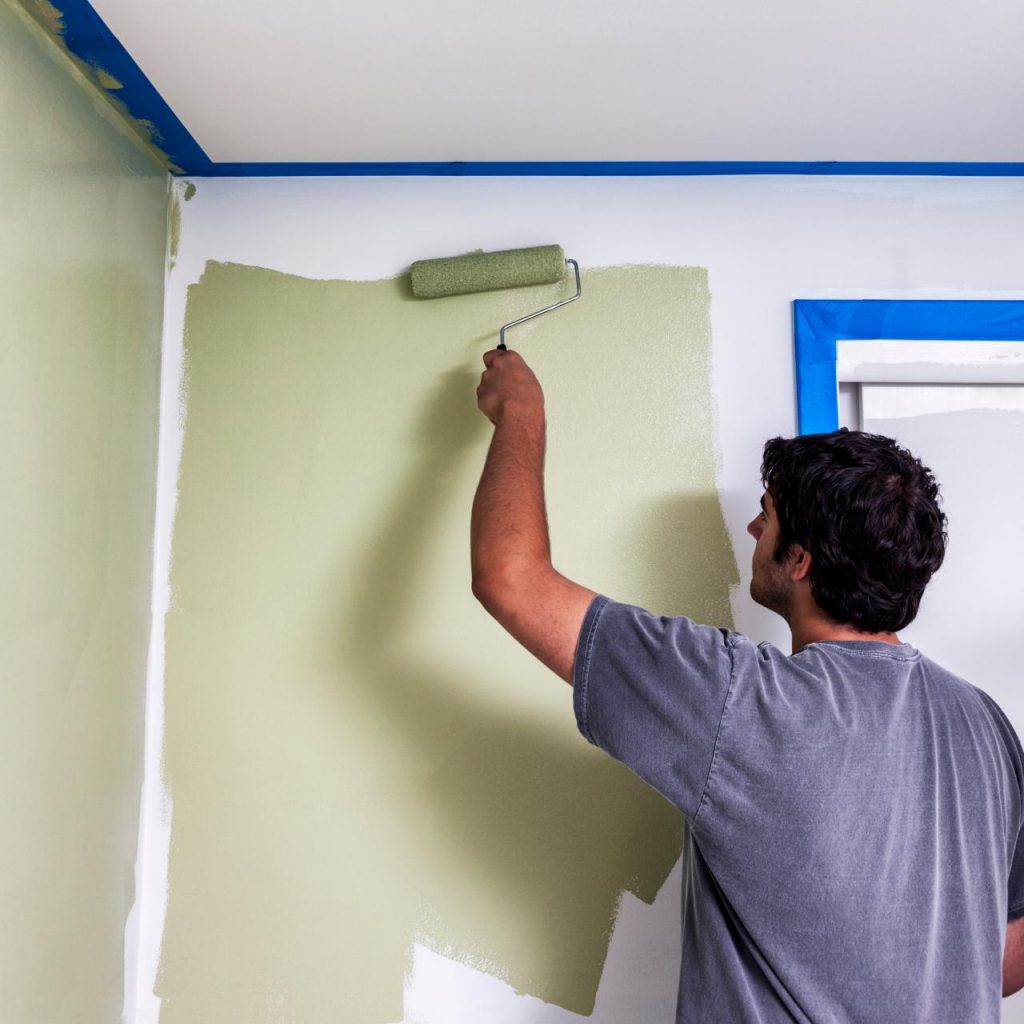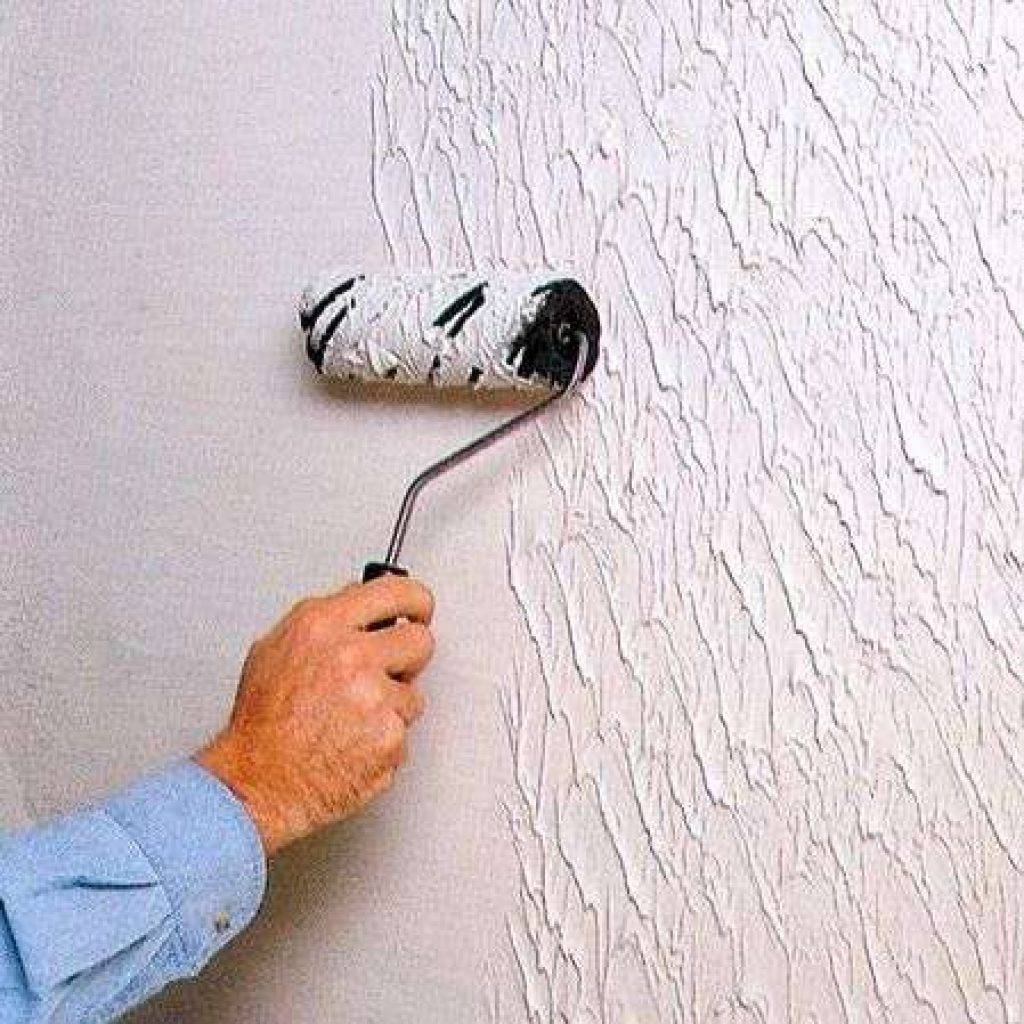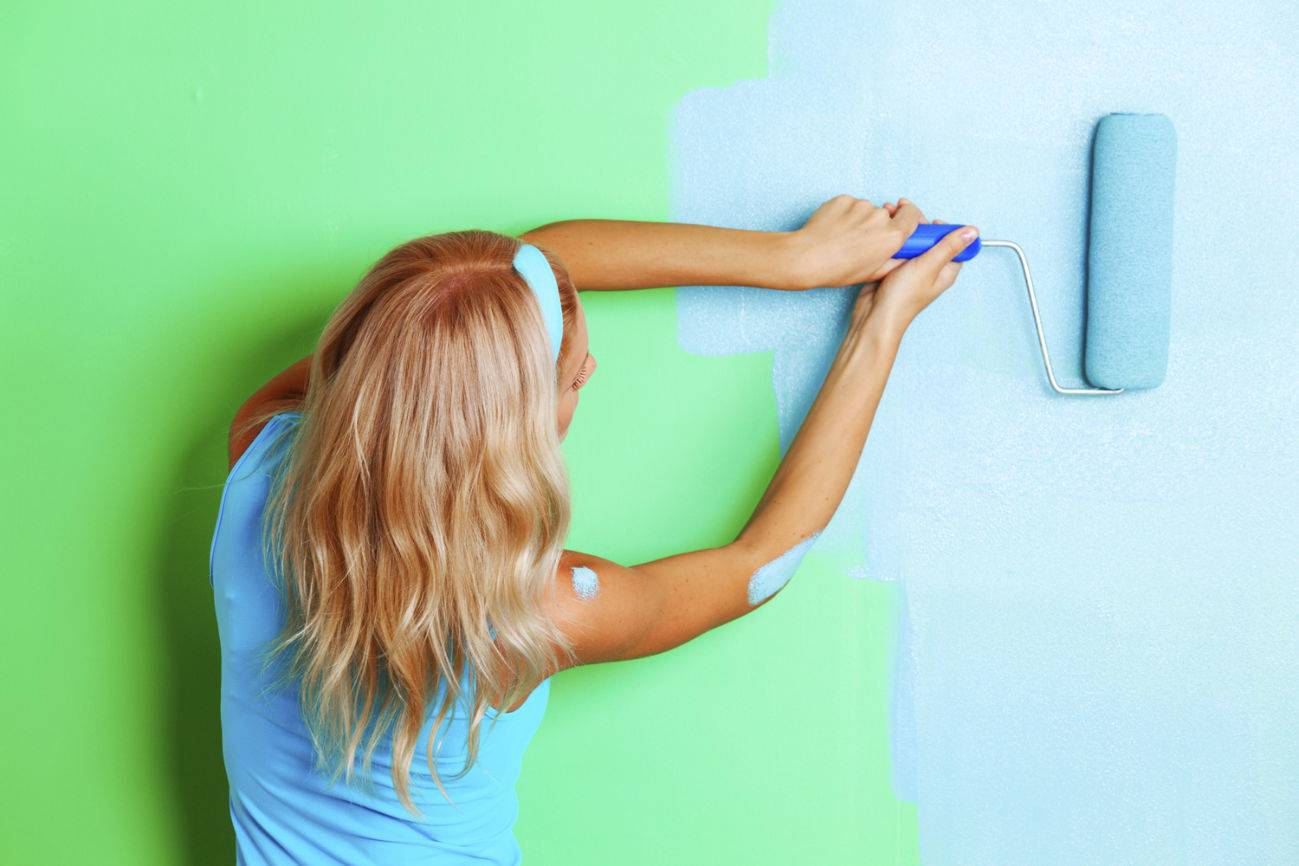Room preparation
Usually, renovations are done in rooms filled with furniture. It is advisable to take it out of the premises. The remaining objects are pushed away from the walls, grouped in the center, and covered with foil. Borders of painting, openings adjacent to the walls can be pasted over with masking tape. Protective equipment for the face and hands should be provided: gloves, goggles, respirator.

Walls must be cleaned of old coating. If coloring is provided instead of wallpaper, then they must be removed, carefully removing the remnants. The walls are then inspected for damage.
Even the most expensive paint will not hide the flaws of the walls, and they can ruin the exquisite design. Therefore, small pits, cracks are putty, after drying, they are rubbed, then primed.
For grouting, you can use an abrasive mesh by placing it on a grinder or handheld machine. These fixtures will help make the surface perfectly smooth.
The task of the primer is to remove dust, to hold the surface layer together. It improves adhesion. After priming, it is possible to identify small blemishes - scratches, bumps. They need to be eliminated by cleaning or filling. Then again you need to sand and prime. When the primer is dry, you can move on to painting.
Compositions for the kitchen, corridor and bathroom
Water-based acrylic and silicone paints are suitable for hallways and kitchens. They are abrasion resistant and washable. A pronounced relief in the kitchen will be inappropriate, so it will be more difficult to maintain cleanliness. And with mother-of-pearl stains, the room can be visually made more spacious.
But for the bathroom, you need to choose paints that are resistant to temperature and moisture. The options listed below are best suited for these purposes, but not for painting the walls in a room:
- Alkyd. They resemble oil compositions in consistency, but differ greatly in their performance characteristics. Painted surfaces perfectly tolerate high temperatures, high humidity, ultraviolet radiation. Vapor permeability is average, can be applied to metal and wooden elements. Alkyd mixture can be matte, glossy, semi-matte. Among the disadvantages: it is diluted with organic solvents, which cause a characteristic pungent odor. An inexpensive option, but not particularly durable.
- Silicate based. An excellent choice for the bathroom. Thanks to the special chemical composition, you do not have to worry that mold or mildew will form on the walls over time. The result is a durable and durable coating, very high vapor permeability. While the composition is drying, it is unhealthy - this is a big minus. Work in protective clothing. Silicates are not compatible with other types of coatings, so they are not applied to surfaces that have already been painted with other paints (it will need to be completely removed).
Painting design
There are a lot of options for painting the walls in the apartment. You need to find the right combination of colors, but this is often a matter of taste. But different methods of combined painting can significantly modify the home interior.
Horizontal division into zones
It is considered the traditional way. More often, the room is divided into two zones: the bottom is painted over with dark shades, and the top - with light shades. Classic: division in height into three parts. Here, the bottom is decorated with a dark shade, and the two upper parts of the walls - with light shades. If you want to decorate the walls with dark shades almost to the very ceiling, then you need to remember that such a technique will visually make the ceiling lower.
If the painting is done on its own, it is difficult to achieve the perfect border of the two colors.But you can decorate the flaws with the help of moldings. Or, before applying other colors, you can carefully glue masking tape along the entire length, helping yourself with a level. After staining, the tape is removed and a perfect line is obtained.
The use of moldings can be attributed to the classics, it is acceptable for country and ethnic styles. But the design with a shiny stripe or just clear borders is closer to hi-tech or minimalism.
Color accents
Accentuating a wall is a fashionable technique when decorating a room. One of the walls is highlighted in a different color. This is usually a darker tone for the background color, or a color that matches the background color. Both options look attractive with the right details. This is an easy way to transform your interior by making it brighter.
But in the bedroom, it is advisable not to use harsh combinations - there the atmosphere should be soft. Sharp contrasts look good in children's rooms, living rooms.
Stripes on the walls
Color type "Horizontal stripe" is appropriate when you need to pay attention to certain decorative elements. A fairly wide strip is placed at eye level
This technique is suitable for the hallway: as the ceiling height decreases, the corridor itself visually becomes wider.
Striped walls are also a very interesting design technique, but it's better not to use it throughout the room. But for accentuating one wall is fine. An interesting effect will be obtained by combining stripes of the same color, but different textures - glossy and matte.
Highlighting interior details is a technique that is used very often. Sometimes, some details are emphasized with a calmer or brighter color: frames, niches, space for placing a beautiful decorative shelf. A popular option is to circle the walls along the contour with a dark strip, highlighting all the corners. A small room will immediately become more spacious visually: it will "expand" both in width and height.
Bathroom wall painting process
Now let's take a closer look at the process: how to paint, how to prepare walls for painting, how to apply the composition.
Calculation of material consumption and preparation of the bathroom
A pre-calculated calculation of consumables will save you from problems with its purchase during the process of painting the walls.
We consider the consumption of putty: this will require the consumption rate of the composition per 1 m2, the area to be treated and the expected layer thickness. The manufacturer indicates all the necessary data on the packaging, it remains to calculate everything according to the dimensions of your bathroom. All data are multiplied among themselves.

Primer consumption rates are calculated from the calculation of the double coating of each painted wall. Usually 0.1-0.15 kg / m2 is taken for the consumption rate. The surface area should be multiplied by the flow rate and the number of coats.
When calculating the consumption of paint, they are guided by its composition and covering ability. The flow parameter is:
-
Oil paint 140-250 g / m2;
-
Alkyd 110-140 g / m2;
-
Acrylic has 115-240 g / m2;
-
Latex 550-600 g / m2;
-
Silicone has 270-300 g / m2;
-
The textured one has 800-1000 g / m2.
Also, the number of coating layers for each type of paint is different: the porosity of the wall and the method of applying the coloring composition play a role. When calculating, the area of the room is multiplied by the consumption rate and the number of layers.
As for the preparation of the bathroom, furniture that can be taken out is taken away, the plumbing is covered with a film.
Base priming
A waterproof primer will be the best choice for treating bathroom walls before painting. The instructions are not written in vain, the manufacturers have already foreseen all possible problems during operation. The label will indicate the drying time of the composition: the staining begins approximately 24 hours after priming.

Paint application
Paint application is the last stage of all work.The result depends on accuracy: plumbing fixtures and floors are also not worth dirtying, so as not to mess with cleaning later.

The first coat is the base that overlaps the primer and serves as the background for the topcoat. The second coat is applied after the base coat has dried. Sometimes a third is applied if there were gaps or the paint lay unevenly.
Video to help:
How to paint walls in an apartment correctly (with video)
Before you paint the walls properly, you need to choose a tool for this job. The walls are painted with enamels most often with a brush. In order to correctly draw paint on the brush, you need to lower it into a bowl (jar), and, taking out, squeeze excess paint on its edge.
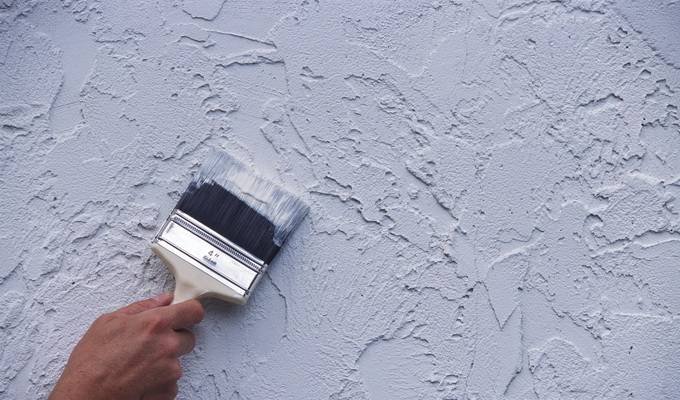
How to paint walls in an apartment: paint is transferred to the surface of the wall with wide and uniform strokes.
You can paint the walls together: one applies the paint, and the other shades it.
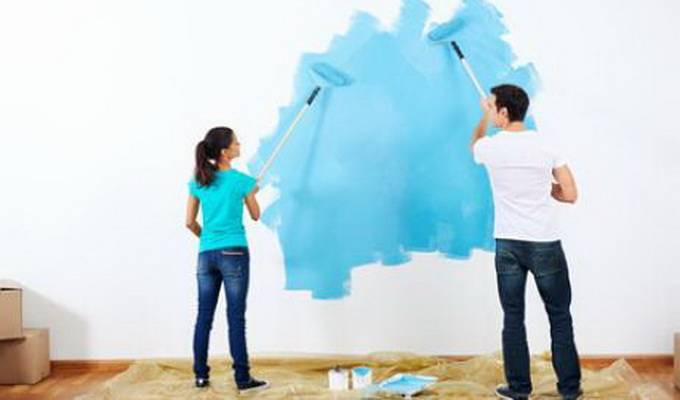
The applied paint is shaded (smeared) in different directions. Most often, shading is carried out in the direction of the light rays falling from the window. In the event that there are several windows in the room, then the paint is shaded along its length.
It is recommended to paint an absolutely flat surface (for example, a wall lined with plasterboard sheets) with water-dispersion (water-based) paints. Unlike most paints based on solvents, water-dispersion compositions form a vapor-permeable coating, which, as it were, “breathes”, which has a beneficial effect on the microclimate of the room.
Most of all water-based paints are based on acrylic binders (acrylic paints). They retain their color well, do not turn yellow, are resistant to washing, are easy to use and allow creating flexible coatings that can “hide” cracks up to 0.5 mm wide.
Numerous manufacturers of water-based paints produce their products, as a rule, in white. To obtain the desired color or shade, a special tinting compound (color scheme) is added to the paint and mixed thoroughly.

Water-dispersion paints are usually applied to the surface to be treated using a roller. To obtain a high-quality coating, the paint is applied in three layers. The first two coats are best painted with a long pile fur roller, using a large amount of paint. Thanks to this, the painted surface does not dry out too quickly, which makes it possible to lay a smoother layer. Finishing painting is done with a paint roller with medium bristles.
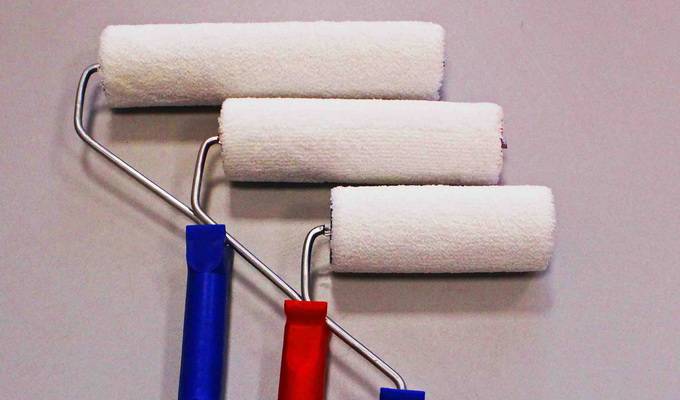
Before a long break, for example overnight, the paint roller must be thoroughly rinsed. If his "fur coat" can be removed, then it is better to do it and wash it separately. After the roller is completely washed (this is determined by the water squeezing out of it - it must be absolutely clean), it must be "fluffed" and hung up with the handle to dry. In order for the pile on the "fur coat" to stand evenly, it is necessary to roll the roller on a clean wall with a sharp motion.
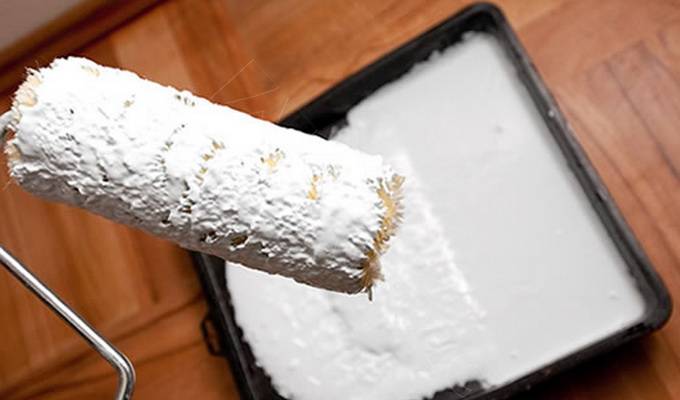
To wet the roller with paint, it is advisable to use a flat box (it is also called a pallet, or a ditch).
A sieve (mesh) with cells measuring 10-20 mm is installed in the box, along which a roller moistened with paint is carried out in order to eliminate excess and evenly distribute the paint along the entire perimeter of the roller.
Instead of a box, you can purchase a special drawer for paint. To eliminate excess and even distribution of paint, it has an inclined ribbed surface.
How to paint walls correctly: the video dismantles all stages of work, including the preparatory part:
Surface preparation tools
The list of tools that will be needed to prepare the walls for painting depends on the material of the old finish - it can be a plaster layer, paint, ceramic tiles, or one of the varieties of wallpaper.
If the walls are covered with plaster that has not been applied evenly enough or has begun to peel off the wall surface, then it must be completely removed. This will require the following tools:
A simple, but very useful tool in the household - a chisel with a plastic shield protecting the hand
- a chisel with a protective plastic handle, or a hammer drill with appropriate attachments;
- hammer;
Brush with metal bristles. There may be varieties for installation in a drill chuck or for a "grinder"
- metal brush attachment for an electric drill or grinder;
- soft brush to remove dust.
- If the wall is being cleaned of old ceramic tiles, the same tools will be required for this process.
- Old paint can be removed from surfaces in different ways, using special solutions or tools. The latter include:
The building hair dryer is a great helper when removing old paint coats.
- construction hair dryer, scraper, chisel and spatula, 120 ÷ 150 mm wide;
- a metal brush-attachment for a drill and a soft brush for removing dust.
To remove the whitewash from the wall, you will need a large sponge, a spray bottle or a paint roller with a fluffy nozzle in order to wet the coating, as well as a spatula or scraper.
Some old finishes require a lot of moisture to remove. A roller with a thick nap or with a foam pad can be used
To remove wallpaper from the walls, different methods are also used, and therefore various tools:
The simplest set of tools for removing old wallpaper
- the simplest and most affordable tools for removing old wallpaper canvases are a spatula and a spray bottle with warm water;
Professional finishers often have such a specific tool in their "arsenal" - a steamer of old wallpaper
- a more expensive tool for cleaning surfaces from this material is a steamer, which allows you to remove the old coating without much effort;
- needle roller.
After removing the old finish, the stages of leveling the walls and their final "finishing" follow. All of this also requires a specific set of tools.
- Building level and plumb line to control the evenness of the walls.
- Rule for leveling plaster.
- Brush and roller for applying the primer.
- Wide and medium sized trowel - for filling surfaces.
- Hand float or sander (eccentric, belt or vibrating) with a set of appropriate sandpaper or meshes - for processing and sanding leveled walls.
- Electric drill with a mixer attachment and a container for mixing the solution.
The work is very dusty. Therefore, in order to ensure personal safety, protective devices for the respiratory tract, eyes and hands must be used when cleaning the walls. And this is especially true if chemical agents will also be used for cleaning.
Next stage
If the original wall is flat, the plaster is preserved on it, the defects are repaired, you can proceed to the finishing. What it will be - puttying or covering the surface with decorative plaster - depends on the type of work chosen. In any case, even walls can already be prepared for painting. It's another matter if they are so crooked that it is almost impossible to cope with them.
In this case, it is more advisable to pay attention to drywall. It can be used to level the surface quite simply and quickly.
True, then it will also have to be prepared for staining, but we will talk about this below.
If you have removed all the old plaster and there is a bare concrete or brick wall in front of you, you will have to level it with plaster mortar using beacons. This is the most effective method that allows you to end up with a truly flat surface.
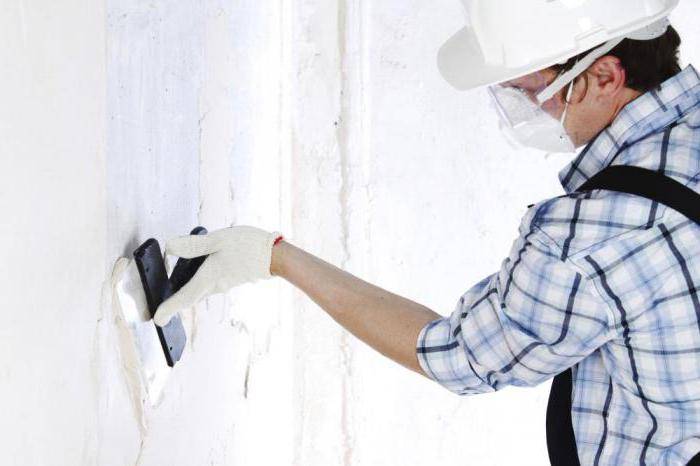
Paints for bathrooms, kitchens and corridors
For kitchens and corridors, the above decorative acrylic paints and water-based silicone paints are suitable. They have sufficient abrasion resistance and can be washed frequently. The use of paints with a pronounced relief in kitchens is not entirely justified - it will be difficult to keep the walls clean. But pearlescent stains can make a small room visually more spacious, especially if the base color is light.
But there are several more moisture and temperature resistant paints that can be used in humid rooms - kitchens and bathrooms, but are undesirable in living rooms.
Alkyd compounds
Alkyd paints in their consistency are very similar to oil paints, but they have a significant difference both in the base (alkyd resins) and in performance characteristics. The surface painted by them tolerates high humidity, elevated temperatures, exposure to ultraviolet radiation well. It has an average vapor permeability, therefore it can be used in humid rooms. It works well on wood and metal surfaces. What else attracts in these paints is that painting the walls does not require significant investments - they are inexpensive. However, a well-prepared surface is required for a normal look. According to the type of surface created, alkyd paint can be glossy, matte, semi-matte.
Examples of alkyd paints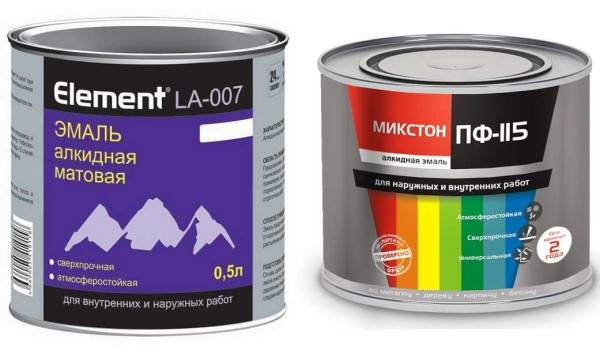
There is only one serious drawback - they are diluted with organic solvents - white spirit, gasoline, turpentine. Therefore, when painting and drying, there is a persistent characteristic smell in the room. Also a minus - they eventually lose color brightness, a yellowish bloom appears. The option is inexpensive, but not the best in terms of durability. They are very good for painting radiators and heating pipes - they can be heat resistant - but a different composition should be used for walls.
Silicate based paints (liquid glass)
If we talk about the specific properties of a silicate coating, then this is a good choice for a bathroom: the chemical composition is such that fungus or mold never appears on the painted walls. If there is such a problem, this is one of the options for solving it. The coating is very strong and durable, and the vapor permeability is the highest among all existing paint and varnish compositions. Therefore, you can use these paints both in the kitchen and in the bathroom.
Silicate paint - prevents the development of fungi and mold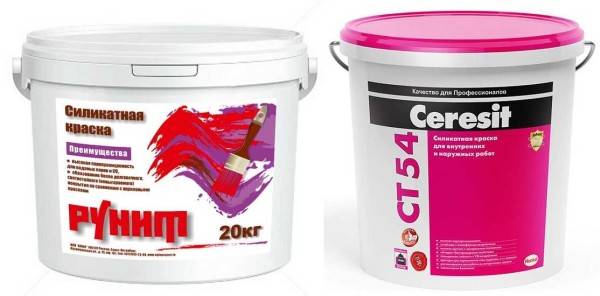
But there are significant downsides. First, until it dries, the composition is very unhealthy. You need to work with him in protective clothing and respiratory protection (good respirator). After drying, the film is absolutely harmless, but it is impossible to stay indoors before crystallization. Secondly, silicates are not compatible with other types of coatings. They do not adhere to surfaces previously painted with any other paint. Likewise, no other surface will "lie" on the surface painted with silicate paint. In both cases, complete removal of the previous layer is required. Thirdly, the compositions are tinted only with mineral pigments, and this significantly reduces the number of colors and shades.
Peculiarities
Painting the walls in an apartment is popular among owners largely because they are able to perform such a procedure with their own hands. This does not require any special knowledge or skills - it is enough to have at least minimal experience with a brush (this should remain from the time of school) and follow the exact procedure for the result to come out both aesthetically attractive and durable.
If paint is used quite rarely for wall decoration in residential premises, then in household premises it is still very relevant. Correctly selected dyes withstand the effects of water, high temperatures and steam much better than even good wallpaper would do, while the painted surface is washed no worse than the tile, and is much cheaper. If necessary, repainting the walls for the sake of cosmetic repairs or updating the design is also not difficult - the procedure will take a maximum of a couple of days and, again, does not require outside help.
In general, wall painting is considered one of the cheapest solutions; a number of possible additional costs must be taken into account.First of all, it all depends on the readiness of the walls, because they must be even and clean, otherwise they will have to be leveled and cleaned from any dirt beforehand, which can lead to an increase in costs even several times. In addition, for better adhesion of paint to the wall, it is advisable to use soil mixtures, ideally in several layers, which also increases the cost of the project.
A separate cost item is the purchase of painting tools, if, of course, you cannot find them for free. First of all, you will need brushes, ideally two: a wide one for painting large spaces and a thin one for drawing small details and painting hard-to-reach places. If the latter are not so many, but the flat surface of the walls is large enough, it makes sense to purchase a paint roller, which will significantly speed up the process. It still needs to be chosen correctly depending on the type of wall surface: foam rubber for smooth surfaces, fur for rough ones. When buying a roller, you will definitely need a painting ditch - a special container with a raised bottom, which allows the painting surface of the instrument to be fully saturated with paint. If you need to provide a clear outline that separates surfaces of one color from surfaces of another shade, you cannot do without a special plastic spatula or masking tape.
This set of tools is typical, but not required or exhaustive. To simplify painting, a spray gun or even aerosol-type cans can be used to replace brushes and rollers. With a small area of \ u200b \ u200bthe room and the use of paint without mixing shades, in some cases, they refuse from a drill with a mixer, replacing it with any available means like a stick.
If we talk about the amount of paint required to paint the walls in the house, then it must be carefully calculated in advance, because in case of a sudden lack of material, the work will have to be interrupted, and it’s also good if the pieces of the walls painted with the purchased mass do not differ in shade. Such calculations are performed according to a fairly simple formula, according to which you need to calculate the area of all walls planned for painting. To do this, the height of each wall is multiplied by its width, and if there are several such walls, the areas of all walls are summed up. Although this area often includes window and door openings, they should not be subtracted to ensure that there is enough paint. Manufacturers in the instructions on the cans usually indicate the typical consumption of their products per square meter - it is enough to multiply this indicator by the area of their walls, and also add 15% for insurance to get the amount of paint needed for painting in one layer. If multi-layer painting is planned, the required volume of material is multiplied by the number of layers.
basic information

For many years now, wall painting has been the most economical type of wall renovation. Thanks to a wide selection of coloring compositions and a competent organization of the painting process, you can achieve excellent results even with a fairly modest budget.
Painting walls as a finishing method is also very popular because it can be done by hand. This does not require any special skills and abilities. It is enough just to be able to work with a brush and act according to a certain algorithm. Then the result will be attractive and durable.
Today, paint is rarely used to decorate living rooms. But for the repair of utility rooms, this option is often chosen. True, dyes in this case are selected special: they withstand well the effects of high temperatures and humidity. Such a painted surface can be washed no worse than a tile, but at the same time it costs an order of magnitude cheaper.In addition, in case of need for cosmetic repairs and interior renovation, you can easily and quickly change the paint. The whole procedure will take a couple of days and will not require outside help.
Color guide
A beautiful wall design will turn out if you choose the compositions in accordance with the chemical structure.
Oil products
Oil paints are made on the basis of mineral and vegetable solvents. After application, the oil components are oxidized, and after drying they form a film. The coating has insufficient durability characteristics - after a certain time it peels off or flakes off.
The compositions have another drawback - the film does not allow moisture vapor to pass through, therefore it is difficult to maintain a normal microclimate in a home.
The inexpensive cost allows you to use products in large quantities, but they are not suitable for painting walls in an apartment.
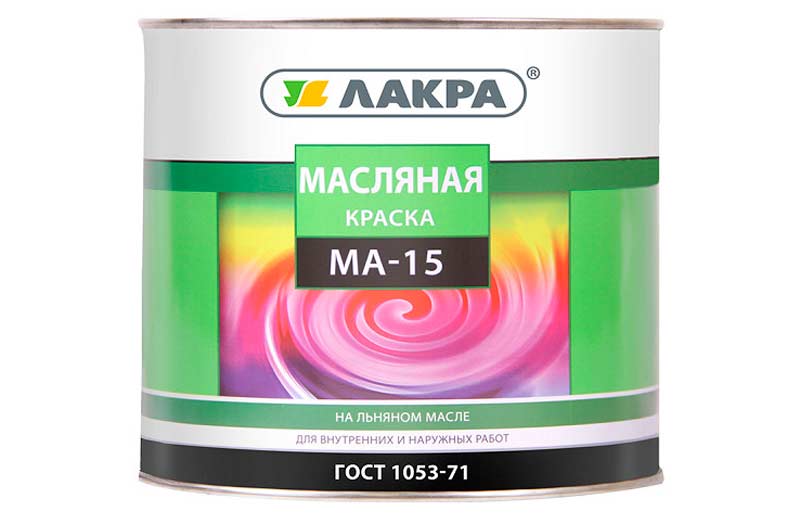
Paints made from alkyd resins
In consistency, they resemble oil, but the binder is extracts from soybean, linseed oil. Organic solvents are used - gasoline, turpentine. The benefits of formulations include:
- fast evaporation without the release of harmful substances;
- formation based on a strong film;
- brightness, resistance of the finish to moisture, temperature fluctuations, ultraviolet light;
- excellent hiding power - paints will create a dense coating without bald spots;
- ideal for the kitchen or bathroom;
- the range of manufacturers includes alkyd products with a matte or glossy effect.
The disadvantages of coloring mixtures are low vapor permeability, the possibility of fire and a pungent smell of solvent during application.
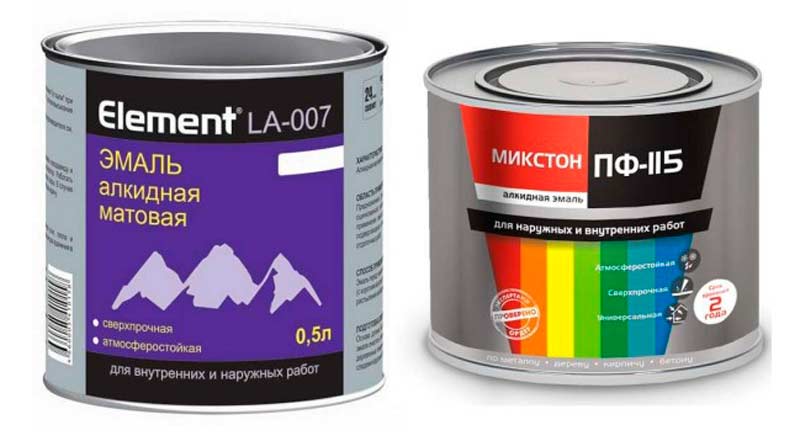
The specifics of silicate products
The peculiarity of silicate paint is its production on the basis of mineral "liquid glass". The durability of the coating allows you to embody any design ideas. Silicate products withstand abrasion, exclude the penetration of mold and mildew, do not require the use of an antiseptic primer.
Always consider the specifics of painting with silicates:
- use gloves, protect the respiratory system and eyes - the paint has a high concentration of alkalis;
- choose an alkaline tinting - the rest will only spoil the composition;
- completely remove the old layer from the surface before painting.
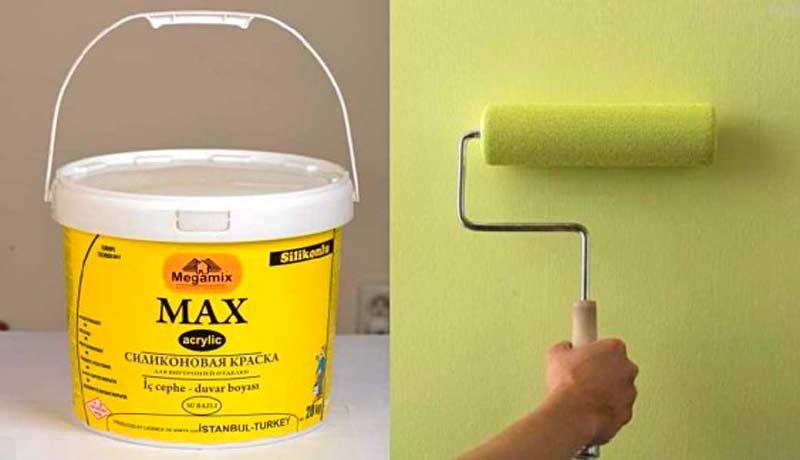
Characteristics of water-soluble products
The solvent of the agents is water, in which the remaining components are present in the form of dispersions or emulsions:
- binding elements - create a film, provide a snug fit and adhesive properties of the material;
- pigments - the composition is painted in a certain color;
- fillers - mineral or quartz dust, crumb, talc, which give the surface a certain texture;
- plasticizer additives - regulate the processes of liquid evaporation and polymerization.
The type of product depends on the film-forming agents.
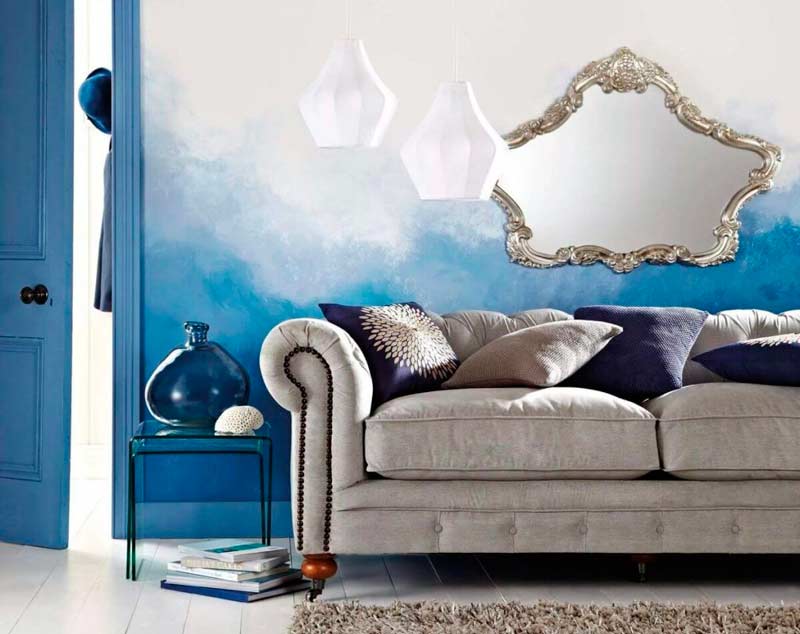
Polyvinyl acetate compounds
Water-based paints are made on the basis of PVA glue and are economical in consumption.
Advantages:
- inexpensive cost;
- painting the walls with water-based paint is fast;
- easy to clean from leather and tools;
- environmental friendliness - there are no unpleasant odors, toxins in the composition;
- good adhesive properties;
- ease of tinting.
Minuses:
minimum moisture resistance.
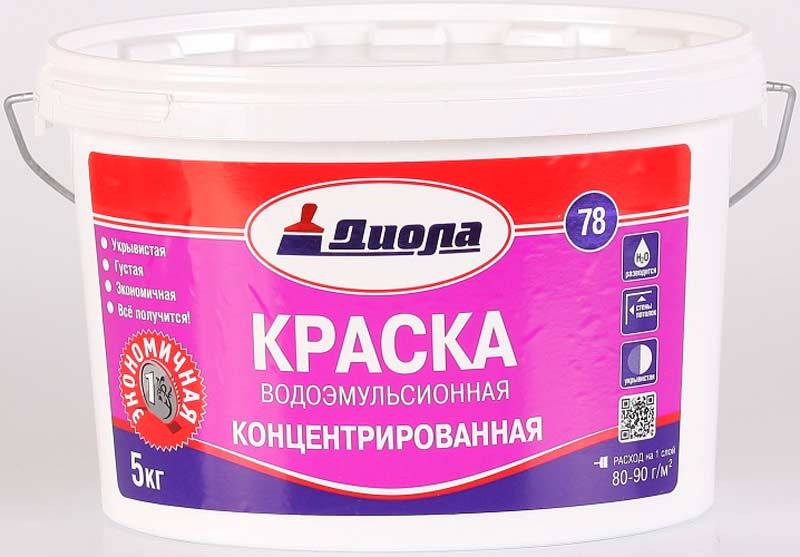
Styrene butadiene dyes
Produced from a variety of artificial rubber, they are rare.
Advantages:
- versatility - can be applied as a primer;
- resistance to abrasion and humid environment.
Minuses:
turn yellow from ultraviolet rays.

Water-based latex products
The composition of water-dispersion products contains latex film-forming components.
Advantages:
- the formation of a waterproof film after polymerization;
- minimum vapor permeability;
- the ability to mask cracks up to 1 mm wide;
- moderate covering ability;
- the best choice if you need to paint the ceiling;
- after applying in 2 layers, the painted walls in the interior look like silk upholstery.
Minuses:
- high price;
- problematic to wash off hands and tools.
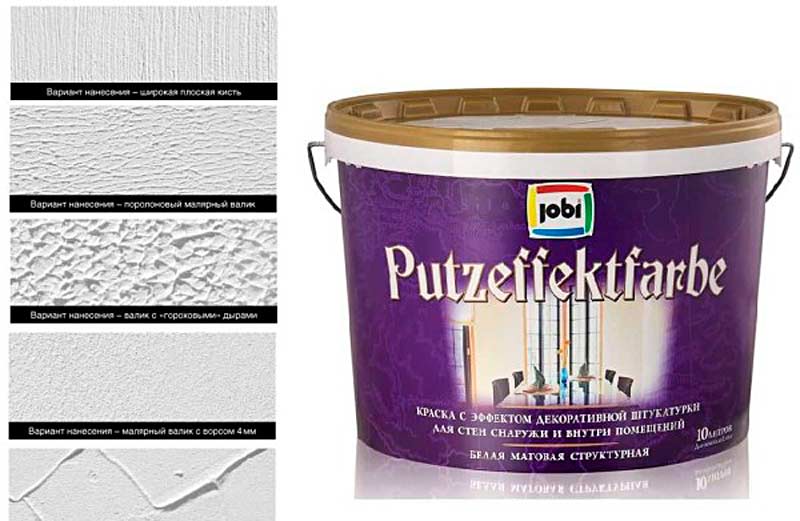
Silicone products
Universal compounds used for painting walls in an apartment or finishing a ceiling.
Advantages:
- excellent covering ability;
- masking cracks with a width of 1.5 to 2 mm;
- resistance to moisture, abrasion, dust;
- vapor permeability;
- durability of the finish;
- environmental friendliness;
- ease of use.
Minuses:
are expensive.

Acrylic dyes
Acrylic is ideal for room decoration and is therefore popular with professional builders and beginners.
Advantages:
- ease of tinting;
- resistance to sunlight;
- abrasion resistance;
- the possibility of application on the ceiling and wall surfaces.
Minuses:
fill only thin cracks (up to 0.5 mm).

Wall alignment methods
Under the old finishing layer, you can expect a surprise in the form of uneven walls. For high-quality painting of the walls, an even base is necessary. It is impractical to proceed to the next stages if this condition is not met. There are various ways to level the walls, each of which will be optimal in each case. Surfaces can be corrected with plaster, putty or drywall.

Plasterboard
A great way to quickly align. Smooth material does not require plastering. The paint can be applied directly to the gypsum board, or on a thin layer of putty. This method is ideal for large rooms. But it is worth mentioning that for wall cladding with drywall, it is required to erect a frame from metal profiles. The design will serve as the basis for the sheets of material, but at the same time will "eat up" a lot of space. It is better not to resort to this technology if every cm is dear to you. The material is not strong enough, it is impossible to place heavy suspended structures on it.

Plaster
Plaster is the most successful option for intermediate finishing if the walls are supposed to be painted. It is applied directly to the wall and creates a perfectly flat surface. To form a thick leveling layer, work is carried out in several stages using beacons.
Step-by-step instruction:
- Mark the wall by setting and fixing landmarks at 60 cm intervals using a plaster mixture.
- Apply a primer to increase the adhesion of the surface.
- Prepare the solution by combining the contents of the bag with water according to the instructions.
- Apply the mixture to the surface, scattering it in brisk strokes using a trowel.
- Distribute the plaster using a rule. Keep your movements short and zigzag.
- We glue strips of facade mesh or fiberglass, and leave the wall to dry completely. This must be done to prevent the formation of cracks in the topcoat.

Putty
Sometimes you can do without plaster altogether. Replace it with putty, which is available as a dry mix. On relatively flat walls, it is enough to apply two layers of this material.
Before proceeding with puttying, you need to prime the wall. This can be done with a roller, but a spray gun will cope with this task faster and better. Next, apply the putty with movements from top to bottom. After drying, we grind each layer with a spatula. It is necessary to eliminate the transitions and bumps formed during the distribution of the composition. The second layer is cleaned with 150 sandpaper, fixed on a special platform. The next step is re-priming the wall and gluing the fiberglass.

How to align the walls?
Having dealt with large irregularities, start leveling all walls. Without alignment, you will see all the flaws that were previously invisible during the finishing painting.To level the walls, you can sand them, plaster them or finish them with drywall sheets.
Plasterboard wall alignment
Grinding is used to level concrete walls. It is only necessary that the base does not crumble, be strong enough and without serious defects. For grinding, you can use "sandpaper" or a special machine. After sanding, all small irregularities / imperfections will disappear.
Wall and ceiling sander
In addition, small defects can be dealt with by cleaning and plastering. As a result, the drops should be no more than 2 m per 1 running meter. m, only in this case you can start plastering and priming. Thanks to the first, the walls will turn out to be perfectly even, the composition is applied in the amount required for complete alignment. If the layer is too thick, it can be applied over the lighthouses - this is how concrete walls are mainly prepared. All surfaces must be primed without fail before puttingty in order to increase adhesion.
Plastering the wall
The next step is to apply a thin finishing layer of putty. Then, when the surface is dry, it is primed and painted. By the way, the starting putty layer must be sanded before applying the finishing layer, but be careful: if you overdo it, you can sand the whole layer. To remove the dust that has appeared, it is better to use a dry cloth, otherwise you can spoil the layer of putty. After applying putty, the walls are re-primed.
Wall primer
How to make a comfortable textured decorative roller quickly
It is permissible to make a roller for the original painting of the walls yourself. There are many features to consider.
From the rope
To do this, you should take an ordinary clothesline or lace. The more often you wind the lace, the more dense the pattern will be. It is permissible to make intersections and other patterns. As a result, it is possible to get a three-dimensional drawing.
With a knife
Use a sharp knife to cut strips or other shapes on the foam roller. The larger they are, the better the texture of the picture will turn out.
Using a plastic bag
This is the simplest and most affordable method. An old roller is suitable for this. It is recommended to attach a crumpled bag to it. The folds help create a complex pattern. Instead of a bag, they use scraps of fabric, rubber bands, paper.
From a rubber roller
To do this, take a rubber roller and cover it with a pattern. Then cut it out with a knife. It is also permissible to use ordinary rubber with a minimum thickness of 5 millimeters.
Foil
To do this, take a thick foil, hook and putty. First, the foil is covered with a pattern. Then crochet it is necessary to squeeze out the relief patterns on the surface. Cover the back wall with putty and press it against the roller. Leave the workpiece to dry. Finally, the foil is glued to the roller.
Thin rubber
First, you should prepare a thin rubber. In addition, you will need a silicone sealant. You will also need a marker. The rubber should be cleaned and degreased. Apply the drawing and repeat the contours with the sealant. Finally, the rubber sheet is glued to the roller.
Wooden rolling pin
This is the most suitable tool. First, remove the handle so that the cylinder remains. After that, make a hole in the center and place the rod in it. Wire is also suitable for this purpose.
Plastic pipe
To do this, you need a pipe 10 centimeters long and 5 centimeters in diameter. Cut the workpiece and make plastic plugs from the ends. Glue them and make holes for the handle.

